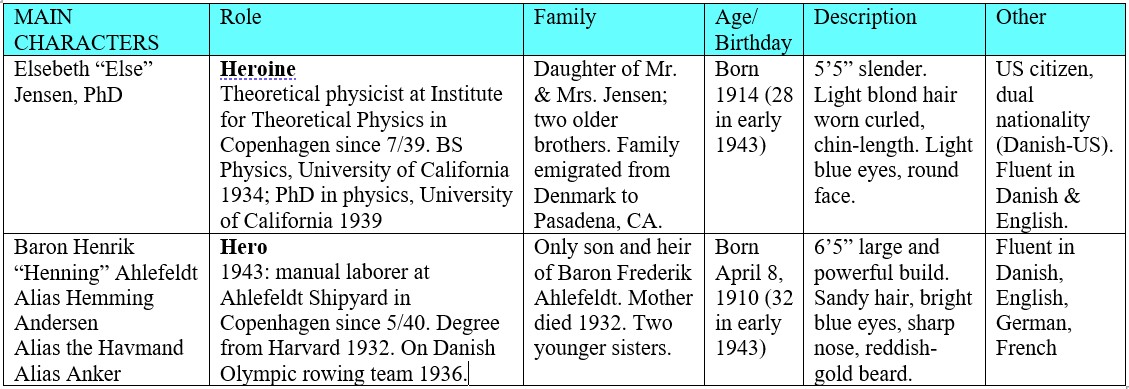Sarah Sundin, @sarahsundin
What color were her eyes again? How long has he had this job? When did she break her arm, and is she out of her cast yet?
When we’re writing a novel, details threaten to swamp us. We waste time tracking them down. We waste time fixing them during editing. And when we mess up, we annoy our copy editors—or our readers!
A character chart can save time and headaches. I use a simple table in Microsoft Word, but you can use Excel or Scrivener as well. The “search” or “find” feature in these programs allows you to quickly locate information. When I wrote three-book series, I kept a running chart for the series to make sure I didn’t duplicate names or overuse character features.
I set up the skeleton of my chart before I start the rough draft (I’m an outliner), enter information in the chart as I write the rough draft, then clean it up during the editing process. When I turn in my manuscript, I also send my character chart—the editorial staff at my publishing house loves this!
Here’s a snippet of the chart from my latest World War II novel, The Sound of Light, showing the main characters, Else Jensen and Henrik Ahlefeldt. Since Else and Henrik are main characters, I include lots of details about them. With side characters, fewer details are needed.
Characters
Each named character receives a row in the table. I group characters by story function, such as “Family,” “Side Characters,” and “Historical Figures.” Sometimes I’ll group them by workplace or other categories.
Name
The first column is for names. I can check my table for repetitions, too many names that start with M, and ethnic diversity. For characters in the military, I include rank and promotion dates. Also include nicknames, including familial nicknames—do her children call her “Mom” or “Mama”? In The Sound of Light, Henrik has several secret identities for his work with the Danish resistance, so I listed those here.

Role
In this column, I state the character’s role in the story—“Else’s grandfather,” “Henrik’s coworker,” and their job if needed. To keep the timeline straight, I can include graduation dates and when the character started or changed jobs or positions.
Family
List the character’s family—birth order, names of parents, siblings, spouse, and children (not shown in detail in this sample, since I have more information for Else’s and Henrik’s families later in the chart). I also list the character’s hometown or nationality.
Age/Birthday
Self-explanatory! But it’s important to know the age of your characters, especially if the book or series spans a longer period of time, or for child characters who change rapidly. This also helps when checking backstory—for example, how old was my heroine when the stock market crashed in 1929? For side characters, this might be only “middle-aged” or “early twenties.”
Description
For major characters, I list height and build, hair and eye color, and other significant features, including scars or disabilities. For minor characters, I only list what’s mentioned in the story, such as “lanky build,” “prominent chin,” “mustache.” Skimming the list can show if certain features are overused.
Other
List any detail you need to track. Does the character wear glasses or speak Mandarin or walk with a limp? Is she a soprano, a tuba player, or a rock collector? I include dates and nature of injuries (I’m mean to my characters!), so I can track their convalescence and make sure the cast doesn’t move from one arm to the other. I also include dates a character is killed or arrested (I told you I’m mean).
A Stitch in Time . . .
With a bit of work in advance, you can create a useful tool to save loads of time later. And your editor—and readers!—will love you.
When the Germans march into Denmark, Baron Henrik Ahlefeldt exchanges his nobility for anonymity, assuming a new identity so he can secretly row messages for the Danish Resistance across the waters to Sweden. American physicist Dr. Else Jensen refuses to leave Copenhagen and abandon her research—her life’s dream—and makes a dangerous decision to print resistance newspapers.
As Else hears rumors of the movement’s legendary Havmand—the merman—she also becomes intrigued by the mysterious and silent shipyard worker living in the same boardinghouse. Henrik makes every effort to conceal his noble upbringing, but he is torn between the façade he must maintain and the woman he is beginning to fall in love with.
When the Occupation cracks down on the Danes, these two passionate people will discover if there is more power in speech . . . or in silence.
Sarah Sundin is an ECPA- and CBA-bestselling author of World War II novels, including The Sound of Light (Revell, February 2023). Her novel Until Leaves Fall in Paris won the 2022 Christy Award, When Twilight Breaks, and The Land Beneath Us were Christy Award finalists, and The Sky Above Us won the 2020 Carol Award. A mother of three adult children, Sarah lives in Southern California and enjoys speaking for church, community, and writers’ groups. She serves as Co-Director for the West Coast Christian Writers Conference. You can find her at http://www.sarahsundin.com





Comments 3
This is so good! Thanks for sharing.
I like the chart. Simple and direct.
This is great! Thanks for the tips! I can get very disorganized.